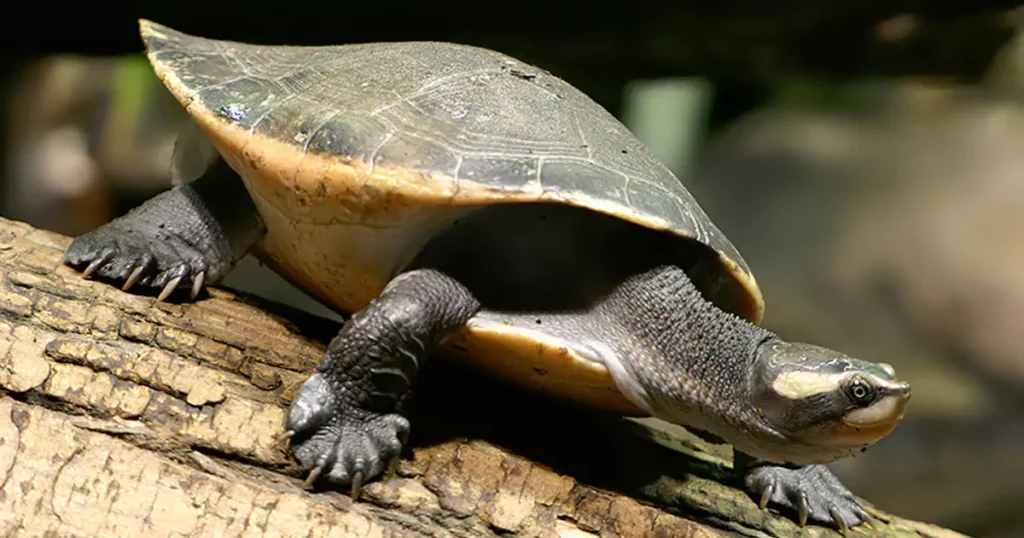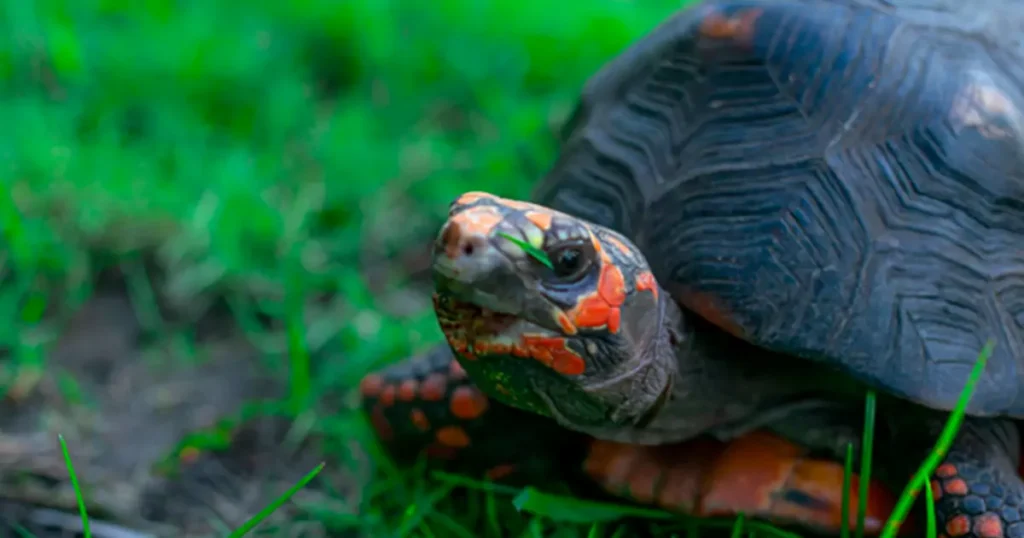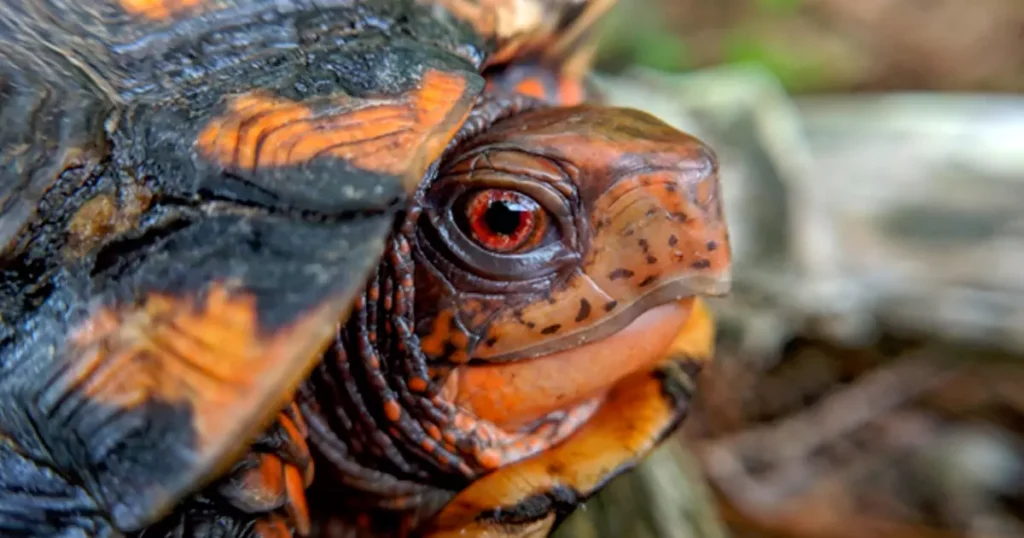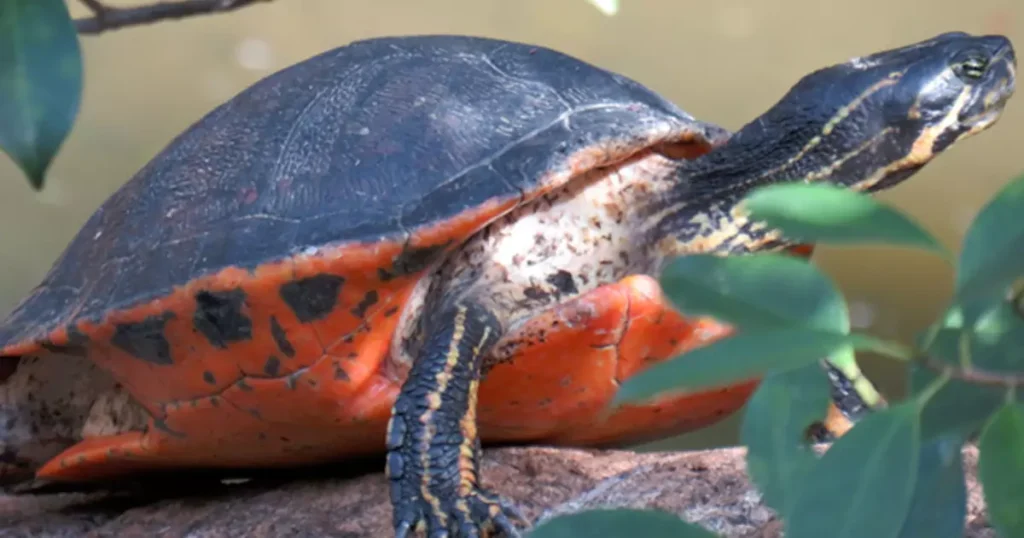Have you ever seen a turtle whose shell held a secret? It’s not a stash of pirate wealth, though that would be cool! It’s something even stranger: a belly glowing with the pinkest pink! Get to know the pink belly sideneck turtle, a cool creature friend from down under. This guide will take you through the ins and outs of a Pink belly sideneck turtle care and species profile.
We’ll cover tank size, care, diet, temperatures, and water factors. Prepare for a trip full of interesting and useful facts about the Pink Belly Sideneck Turtle.
Table of Contents
Origins of Pink Belly Sideneck Turtles

The Pink Belly Sideneck Turtle, officially known as Emydura subglobosa, is a captivating species native to Australia. Recognizable by its unique pink belly and adorable appearance, this turtle has become a favorite among reptile enthusiasts.
Pink Belly Sideneck Turtles are friendly and curious. They might be a bit shy at first, but once they get to know you, they become great friends. They enjoy exploring their surroundings, both in the water and on land.
Unique Appearance of Pink Belly Turtle
An amazing contrast is made by the turtle’s brown or olive-colored shell and its clear pink belly. The turtles are so cute when they are babies, and as they get bigger, the pink on their bellies stands out even more.
Now, here’s where the magic happens – flip this turtle over, and surprise! Its belly is like a pink jewel hiding underneath. Yep, you heard it right – a PINK belly! It’s like having a secret pop of color in a turtle package. This pink-bellied wonder is like a live work of art, making it a standout star in the turtle kingdom. So, whenever you meet this cool critter, take a moment to appreciate its unique and fabulous appearance – nature’s way of showing off its creativity!
Pink Belly Sideneck Turtle Care

If you’re considering caring for a pink belly sideneck turtle, prepare for a journey full of splashing, sunshine, and, of course, that lovely pink glow! But keep in mind that these wonderful creatures require special care in order to thrive. So, let’s get started on keeping your pink-bellied pal happy and healthy!
Their Fantasy Aquatic Palace
Consider a dazzling aquatic oasis with flora to explore and sunbeams to soak up. That’s where your turtle should live! Here’s what you should know:
- Size Matters: Hatchlings can live in a 20-gallon tank, but adults require a large tank with at least 40 gallons of water. Consider a massive undersea castle!
- Water Works: They prefer warm baths, therefore keep the temperature of the water between 76°F and 83°F. Consider it their own secret tropical paradise!
- Sun’s Kiss and Shady Retreats: Set up a basking area with a heat lamp so they may drink up the rays of the sun like small underwater sunbathers. Add some shaded hideaways, such as stones or fake plants, where they may cool off and feel safe.
Turtle Treats and Tasty Times
These young gourmets love a variety of meaty treats and vegetable delicacies. Consider them to be underwater chefs with discriminating tastes!
- Fishy Feasts: Fish, worms, and other meaty goodies are their favorites. Think of little underwater fishermen catching their dinner!
- Veggie Variety: Include some veggie goodness in their diet, such as lettuce, carrots, and leafy greens. Consider them salad lovers with shells!
- Feeding Schedule: Feed them every other day and make sure the food is the proper size. You wouldn’t give a goldfish a full watermelon, would you?
Maintaining Squeaky Clean
Turtles, like us, appreciate clean water! Here’s how you can maintain their home spotless:
- Water Changes: Perform partial water changes every week and deep clean the entire tank once a month. Consider spring cleaning their palace!
- Testing Period: Test the water regularly for things like pH and ammonia levels to ensure it’s safe for your turtle. Consider it a mini-science project to keep their water clean!
Remember that caring for a pet is a huge responsibility. Before bringing any animal into your home, always do your research and be sure you can give sufficient care. However, with love, attention, and these helpful hints, you can establish a happy and healthy environment for your pink-bellied pet and enjoy an incredible friendship that shines as brightly as their beautiful bellies!
Habitat of Pink Belly Sideneck Turtle

Pink Belly Sideneck Turtles are native to northern and eastern Australia’s freshwater ecosystems, where they can be found in slow-moving rivers, ponds, and lakes. They flourish in areas rich in aquatic vegetation, submerged logs, and sandy bottoms, which provide both refuge and a varied range of food sources.
Pink belly sideneck turtles, like many other turtle species, engage in basking rituals to maintain their body temperature. You might see them sunbathing on rocks or logs along the water’s edge. This behavior not only allows them to absorb necessary UV rays for appropriate shell development, but it also allows for good observation.
Full Grown Pink Belly Sideneck Turtle

Baby pink belly sideneck turtle are little miracles when they hatch from their eggs, hardly larger than a golf ball. They have shells the size of a thimble and weigh less than a gummy worm! But don’t be fooled by their diminutive size. These young adventurers are full of potential and eager to learn.
Pink Belly Sideneck Turtle mature into gorgeous reptiles as they reach adulthood. Discover the secrets of their growth, including the elements that impact pink belly sideneck turtle size, and why these turtles are popular among turtle aficionados of all ages. These amazing turtles start small, but as they grow older, they can reach adult sizes of 6 to 10 inches (15 to 25 centimeters). Consider a ruler – that is the maximum length they can reach!
They may not be breaking any “world’s largest turtle” records, but they are no longer teeny-tiny. They have a sleek, oval-shaped shell that can be brown or olive, and don’t forget about the star of the show – their gorgeous pink belly! These full grown Pink Belly Sideneck turtles are set to rock the turtle world, from pocket-sized cuties to just-right, grown-up turtles.
Read More: The Ultimate Guide To Cumberland Slider Turtle Care
FAQs
Q: What is a Pink Belly Sideneck Turtle?
A: It’s a fascinating freshwater turtle found in Australia and Papua New Guinea. These adorable creatures, named for their gorgeous pink bellies and flexible necks that bend sideways, spend the majority of their time splashing around in ponds, rivers, and swamps.
Q: How Big Are Pink Belly Sideneck Turtles?
A: Pink Belly turtles are around the size of a penny. They can grow to 10–12 inches (25–30 centimeters) as adults. Imagine a nice small pal becoming a cool, medium-sized turtle!
Q: Pink Belly Sideneck Turtles—Can They Get Along?
A: They can, but choose turtle friends carefully. Most Pink Belly Sideneck Turtles get along with other turtles of their size and temperament. Like making human friends, introduce them cautiously and make sure everyone gets along!
Q: Are Pink Belly Sideneck Turtles Endangered?
A: Good news! Pink Belly Sideneck Turtles are not endangered. However, it’s incredibly vital to take care of their homes in the natural, such as rivers and ponds, to keep them happy and healthy. We want to make sure these amazing turtles continue to thrive in their natural homes.
Q: What Do Pink Belly Sideneck Turtles Eat?
A: Sideneck Pink Belly Turtles are not snapping turtles, but they are just as interesting! These cuties are omnivores, which means they eat both plants and small things. They adore nibbling on veggies, fruits, and even some delectable insects. So, their mealtime is like having a colorful salad with a side of bugs!
Q: How Friendly are Pink Belly Sideneck Turtles?
A: They certainly are! While they are not as cuddly as a cat or dog, they are surprisingly social animals that commonly live in groups in the wild. They can become at ease with you with careful handling and care.
Read More: A Comprehensive Guide To Reeves Turtle Care & Species Profile
Final Thoughts
You have successfully entered the fascinating realm of the Pink Belly Sideneck Turtle. These turtles have won our hearts with their particular charm, from their cute newborn days to their majestic full-grown stature. Remember the importance of conservation and how you can help protect our planet’s tremendous biodiversity as you continue to learn and explore. Enjoy your turtle travels!
Hope this information is useful to you on your turtle-tastic adventure! If you have any queries, please leave them in the comments section below. Remember to share this article with your animal-loving friends!
